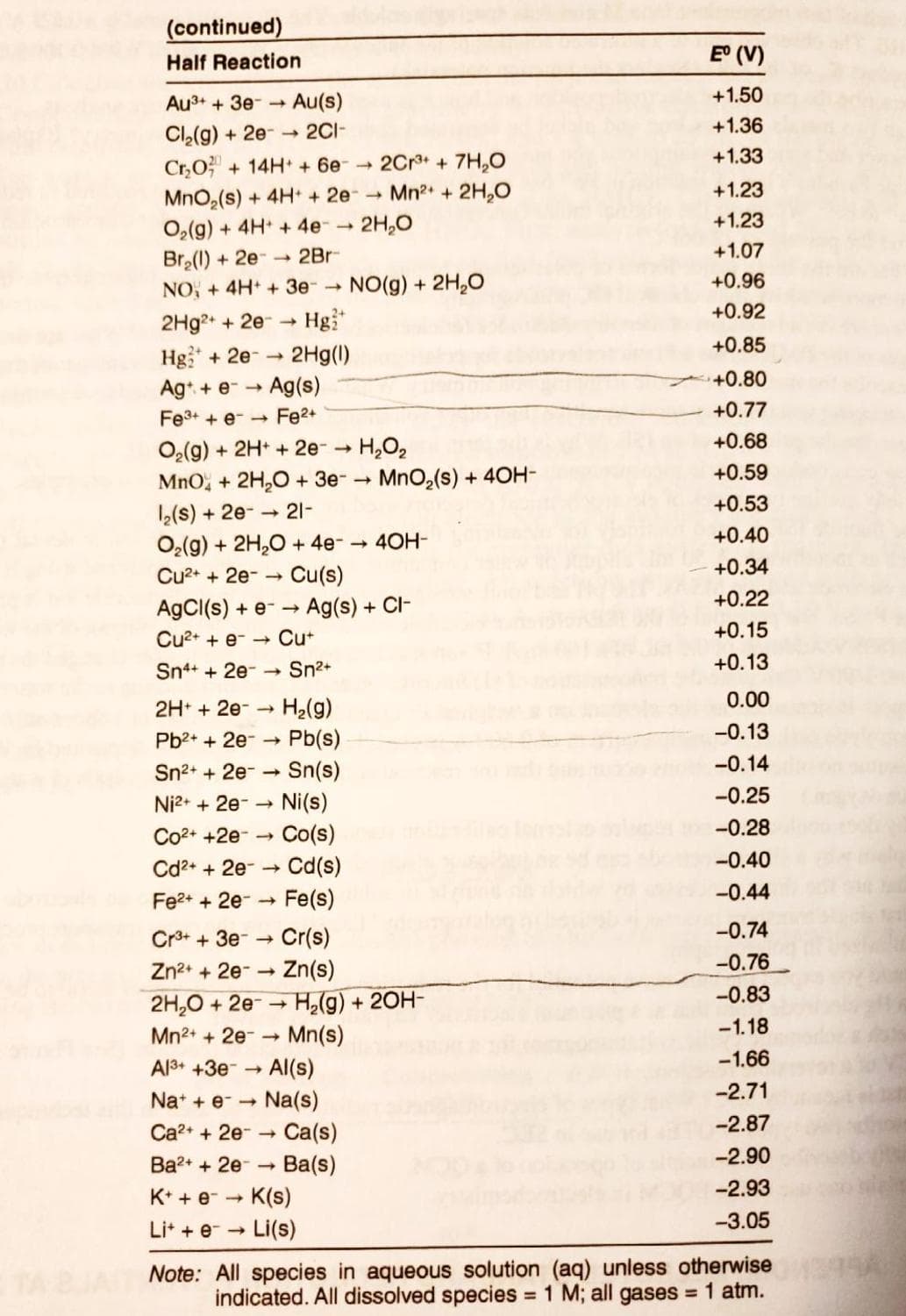Chapter13: Titrations In Analytical Chemistry
Section: Chapter Questions
Problem 13.11QAP
Related questions
Question
100%
Calculate the Eo and the E for this cell.

Transcribed Image Text:(continued)
Half Reaction
Au³+ + 3e- →
Cl₂(g) + 2e- →
Cr₂O + 14H+ + 6e- →2Cr³+ + 7H₂O
MnO₂ (s) + 4H+ + 2e → Mn²+ + 2H₂O
2H₂O
O₂(g) + 4H+ + 4e-
Br₂(l) +2e2Br-
NO + 4H+ + 3e-→ NO(g) + 2H₂O
► Au(s)
2C1-
2+
2Hg2+ + 2e → Hgit
Hg+2e → 2Hg(l)
Ag+ e-→ Ag(s)
Fe³+ + e-
Fe²+
O₂(g) + 2H+ + 2e- → H₂O₂
MnO + 2H₂O + 3e- → MnO₂ (s) + 40H-
2₂(s) + 2e- →
O₂(g) + 2H₂O + 4e-→ 40H-
Cu²+ + 2e-
AgCl(s) + e- →
Cu²+ + e- →
Sn4+ + 2e →→ Sn²+
->
21-
Cu(s)
► Ag(s) + CI-
2H+ + 2e → H₂(g)
Pb²+ + 2e-→ Pb(s)
Sn²+ + 2e- 1
Sn(s)
Ni2+ + 2e → Ni(s)
Co2+ +2e
Co(s)
Cd²+ + 2e → → Cd(s)
Fe²+ + 2e- Fe(s)
->>
Cu+
Cr³+ + 3e
Cr(s)
Zn²+ + 2e → Zn(s)
->
2H₂O +2eH₂(g) + 2OH-
Mn²+ + 2e- Mn(s)
Al³+ +3e Al(s)
Na+ + e- Na(s)
-
Ca²+ + 2e → Ca(s)
Ba²+ + 2e Ba(s)
K++ e->
Li++e
K(s)
Li(s)
E° (V)
+1.50
+1.36
+1.33
+1.23
+1.23
+1.07
+0.96
+0.92
+0.85
+0.80
+0.77
+0.68
+0.59
+0.53
+0.40
+0.34
+0.22
+0.15
+0.13
0.00
-0.13
-0.14
-0.25
-0.28
-0.40
-0.44
-0.74
-0.76
-0.83
-1.18
-1.66
-2.71
-2.87
-2.90
-2.93
-3.05
TABIAT Note: All species in aqueous solution (aq) unless otherwise
indicated. All dissolved species = 1 M; all gases = 1 atm.
![Cu
electrode
lead
Copper
electrode
CuSO4
solution
(a)
Meter
common
lead
[Cu²+] = 0.0200 M
Voltmeter
0.412 V
Com
Very high resistance
Salt bridge
Saturated KCl solution
Meter
positive
lead
[Ag+] = 0.0200 M
Ag
electrode
lead
Silver
electrode
AgNO3
solution](/v2/_next/image?url=https%3A%2F%2Fcontent.bartleby.com%2Fqna-images%2Fquestion%2Fdb688f85-aacf-4966-891c-9ccccc50e8d7%2F27c8f28c-4748-4c38-960d-98952a94e9af%2Fvw633ib_processed.jpeg&w=3840&q=75)
Transcribed Image Text:Cu
electrode
lead
Copper
electrode
CuSO4
solution
(a)
Meter
common
lead
[Cu²+] = 0.0200 M
Voltmeter
0.412 V
Com
Very high resistance
Salt bridge
Saturated KCl solution
Meter
positive
lead
[Ag+] = 0.0200 M
Ag
electrode
lead
Silver
electrode
AgNO3
solution
Expert Solution
This question has been solved!
Explore an expertly crafted, step-by-step solution for a thorough understanding of key concepts.
Step by step
Solved in 6 steps

Knowledge Booster
Learn more about
Need a deep-dive on the concept behind this application? Look no further. Learn more about this topic, chemistry and related others by exploring similar questions and additional content below.Recommended textbooks for you

